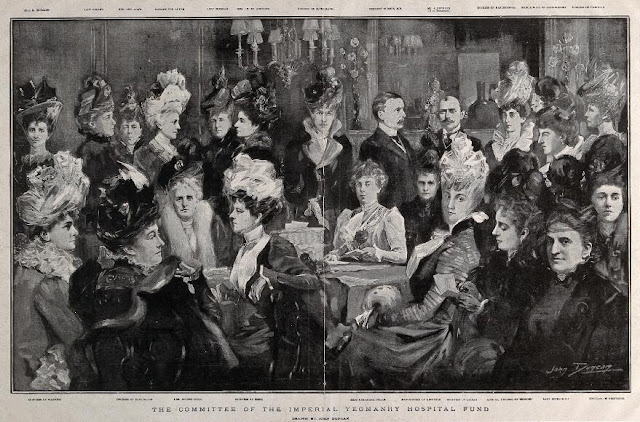In some ways, Lady Alice Knox is the odd woman out in the Ladies Committee. At the time of her appointment, she wasn’t a public campaigner for women’s rights or actively involved in improvements to education nor was she involved in health.
Thus, she’s a shadowy figure, the wife of an important military man, Sir William George Knox, of the Royal Horse Artillery, who had served in all the famous British Empire conflicts of the latter 19th Century – the Abyssinian, Ashanti, Afghan and Zulu Wars and ultimately the Boer War. (In appearance he looks to be the absolute epitome of Gilbert & Sullivan’s Major-General.)
Alice was most likely recruited because of her husband’s
connections in South Africa during the time the Ladies Committee was travelling
and reporting on the concentration camps, so she might best be described as a “facilitator”
and purely there to smooth the way through authorities and red tape.
Alice and her husband had been trapped in Ladysmith during the
famous siege so she did have some frontline experience although there is no record
of her ever having talked or written about it afterwards.
Again, it is difficult to find any portrait or photo of the adult Alice and the only one readily available in the UK National Portrait Gallery is this one of her as a child with her brother and sister. Perhaps she is the one wearing a hat.
Below is an image of Alice’s mother, Emily, from the Dundas family website.
Alice’s birth date seems to vary. In some reports it is shown
as 1863, but Scottish records indicate that it was much earlier, 22 August 1855. Her
father was Sir Robert Dundas, 1st Baronet of Arniston and her mother,
Emily, was a member of the Knox family. Alice was a cousin of her future
husband. She was married to Sir William in St Paul’s Knightsbridge in July,
1889. They would have no children.
Alice died at Marazion, Cornwall, on 5 August 1929 and left a
substantial estate in excess of 45,000 pounds, or around 3 million pounds in
today’s value.
An obituary from The London Times of August 10, 1929 indicates
that Lady Knox was a council member of the Society for the Oversea Settlement
of British Women.
Alice was also involved in a similar scheme resettling
soldiers and their whole families in a similar way. Like many of the grandiose soldier
settlement schemes following WW1, the success rate was low and by the time it
folded in 1930, Alice would be dead. Alice and her husband are both buried in
the churchyard at Temple, Midlothian, Scotland, not far from Alice’s ancestral
home at Arniston.
 |
| The grave at Temple |
There are some smatterings in archival newspapers of Alice giving talks or reports on the overseas emigration scheme; here is a link to one about the first army settlement in Western Australia in the Country Life Stock and Station Journal 17 February 1925. Note that Lady Knox introduced the group to Queen Mary in Buckingham Palace shortly before their departure. It would be interesting to find out how the families fared.
Links to other posts in this series about the members of the Ladies Committee sent to investigate the Concentration Camps in South Africa:-
Personal library sources include:
"The Concentration Camps of the Anglo-Boer War, A Social History" by Elizabeth Van Heyningen
"Rebel English Woman, The Remarkable Life of Emily Hobhouse" by Elsabe Brits
"The Compassionate Englishwoman" by Robert Eales
"The Boer War" by Thomas Pakenham
"Those Bloody Women, Three Heroines of the Boer War" by Brian Roberts








